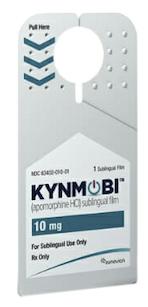Apomorphine and Alcohol/Food Interactions
There is 1 alcohol/food/lifestyle interaction with apomorphine.
Apomorphine Food
Moderate Food Interaction
Consumer information for this interaction is not currently available.
GENERALLY AVOID: Alcohol and apomorphine may have additive hypotensive and sedative effects. Coadministration of 0.6 or 0.3 g/kg of ethanol with apomorphine in healthy subjects resulted in greater decreases in blood pressure compared to apomorphine alone. The mean largest decrease (the mean of each subject's largest drop in blood pressure measured within 6 hours after apomorphine administration) in standing systolic and diastolic blood pressure was 6.7 and 8.4 mmHg, respectively, with apomorphine alone. When coadministered with 0.6 g/kg of ethanol (equivalent to approximately 3 standardized alcohol-containing beverages), the mean largest decrease in standing systolic and diastolic blood pressure was 11.3 and 12.6 mmHg, respectively (standing systolic and diastolic blood pressure decreased by as much as 61 and 51 mmHg, respectively, in this group). When coadministered with 0.3 g/kg of ethanol, the mean largest decrease in standing systolic and diastolic blood pressure was 8.4 and 7.1 mmHg, respectively.
MANAGEMENT: Patients should be advised to avoid consumption of alcohol during apomorphine treatment.
References
- (2022) "Product Information. Apokyn (apomorphine)." US WorldMeds LLC
- (2022) "Product Information. Kynmobi (apomorphine)." Sunovion Pharmaceuticals Inc
- (2024) "Product Information. Dacepton (apomorphine)." Ever Pharma UK Ltd
- (2024) "Product Information. aPomine Intermittent (apomorphine)." Pfizer Australia Pty Ltd, 1.1
- (2024) "Product Information. Movapo (apomorphine)." Stada Pharmaceuticals Australia Pty Ltd
Apomorphine drug interactions
There are 577 drug interactions with apomorphine.
Apomorphine disease interactions
There are 2 disease interactions with apomorphine which include:
More about apomorphine
- apomorphine consumer information
- Check interactions
- Compare alternatives
- Pricing & coupons
- Reviews (4)
- Side effects
- Dosage information
- During pregnancy
- Drug class: dopaminergic antiparkinsonism agents
- Breastfeeding
- En español
Related treatment guides
Drug Interaction Classification
| Highly clinically significant. Avoid combinations; the risk of the interaction outweighs the benefit. | |
| Moderately clinically significant. Usually avoid combinations; use it only under special circumstances. | |
| Minimally clinically significant. Minimize risk; assess risk and consider an alternative drug, take steps to circumvent the interaction risk and/or institute a monitoring plan. | |
| No interaction information available. |
Further information
Always consult your healthcare provider to ensure the information displayed on this page applies to your personal circumstances.


